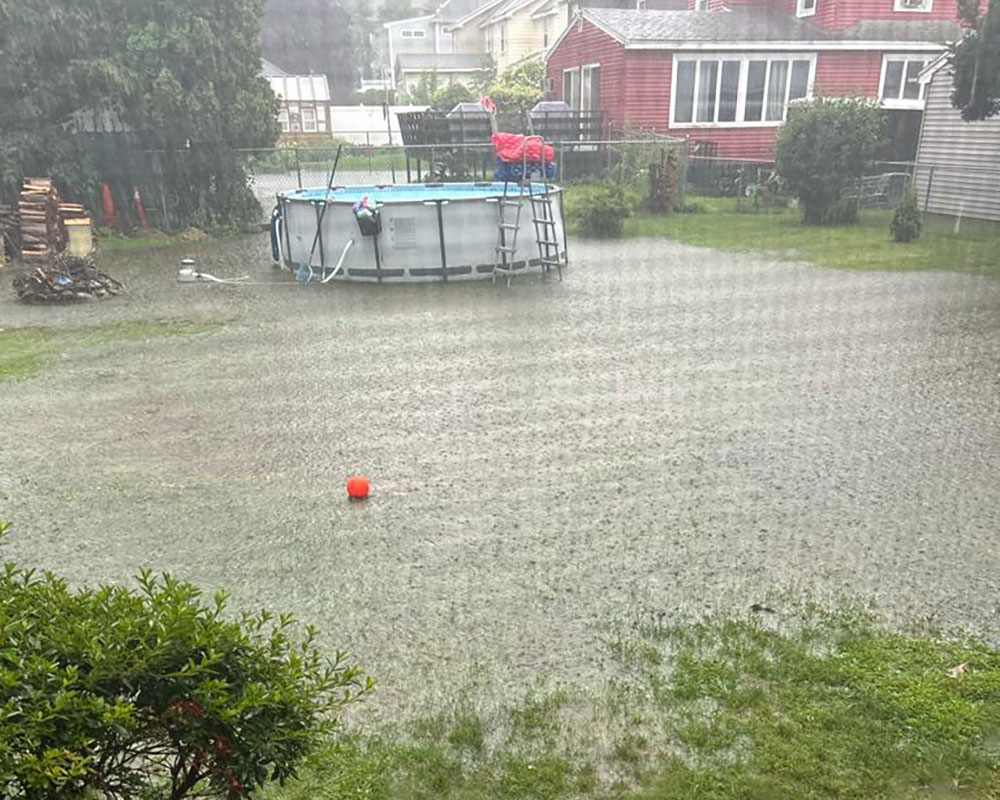Part 1 of an occasional series.
State officials report a housing shortage as demand far outstrips supply. In Haverhill, some residents wonder where they fall in the city’s priorities after development has increased in recent years. In light of a contentious zoning board meeting in January, a WHAV series explores concerns raised about impacts on the environment, overdevelopment with insufficient infrastructure and the character of long-settled neighborhoods changing.
After two dozen Wood School-area residents showed up at a Haverhill Board of Appeals meeting in January, a developer was forced to reduce his proposal from four homes to three.
Though victorious, they seemed unsatisfied as they mingled in the hallway after the meeting. Top of mind for a neighbor who helped bring the group together, Dave Gaiero, was flooding, which he said has gotten worse in recent years.
In an email last week, City Engineer John H. Pettis III told WHAV “engineering has recently been forwarded a few videos of the neighborhood during rain events and we will be making site visits.” He said addressing infrastructure issues raised by neighbors would be “very expensive.”
Gaiero said he heard from a neighbor, Lisa McElroy, that people with tablets and phones were touring the area, maybe taking pictures, last week. He followed up with the city and heard it would be a “long and expensive process to try to find out” the problem and proper solution.
Outside the city hall meeting room, Gaiero explained that water flows down the boundary separating his house from the property in question, sharing a video showing a stream near a white fence. “We always had a little standing water if it rained hard, in front of the shed, always,” Karen Gaiero, his wife, said. “But the last, I’d say five or six years, it’s turned into this.”
They have lost the use of their backyard, which has a little patio, when it rains.
The Gaieros and the McElroys, another couple in the area, hosted a discussion among concerned neighbors after some received letters from the zoning board before the January meeting. Lisa McElroy said her yard becomes a “pond” fed by the stream from near Dave’s shed. His mulch and another neighbor’s vegetables often float down to her place.
The culprit, the two couples suspect, is the new Caleb Dustin Hunking School. They said water winds its way down from the higher elevation structure, finding its way onto properties, into homes and wearing cracks along the sides of the roads.
Pettis disputes that extra water comes from the school, saying the design follows the Massachusetts Stormwater Management Standards, which requires that “the peak discharge rates of stormwater from the site post construction was equal to or less than pre construction.”
“Unfortunately, similar to many other communities in the state and country, Haverhill has seen an increased occurrence of higher rainfall events in recent years,” he said. “The experts performing climate modeling indicate that the occurrence of severe weather events will likely continue to increase.”
Walking through the neighborhood, the McElroys were eager to point to all the problems with their roads: improperly renovated gas lines, awkward drainage placement, large cracks along the sides of some roads and, at the top of their list, no sidewalks. When it rains, they said water streams alongside the street, running into yards and basements because no gutter is there to channel it.
“The water pours down the street so much, it wears away the soil, sinks under the tar, and then the tar just collapses over it,” Paul McElroy said.
One corner of an intersection has caved in completely, revealing packed dirt grooved with tire treads underneath loose chunks of asphalt. In an area where residents walk on roads with no sidewalks, increased traffic from Hunking was another concern raised at the Board of Appeals meeting.
Pettis echoed residents’ assessment that the existing infrastructure in the neighborhood allows increased precipitation onto their lots, though he said an upgrade would be “very expensive.”
“In addition to the costs of installing the curbing/sidewalk, because stormwater is now being contained in the roadway, catch basins, manholes and stormwater pipe need to be added to catch that rainfall, and direct it to a proper area,” he wrote in an email to WHAV. Much more piping would need to be built so the water can be treated before entering a wetland or water body.
On top of that, current drainage in the neighborhood is tied into the city’s sewer system, and Pettis wrote that the city “is mandated to NOT install any additional catch basins” because a severe storm would require “the release of untreated flow to the river.” According to consultants the city hired, he said properly separating the sewage and stormwater systems costs “tens of millions of dollars for each neighborhood.”
